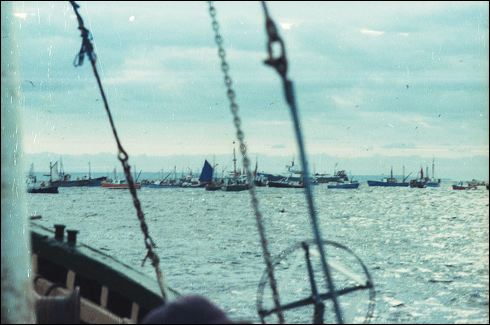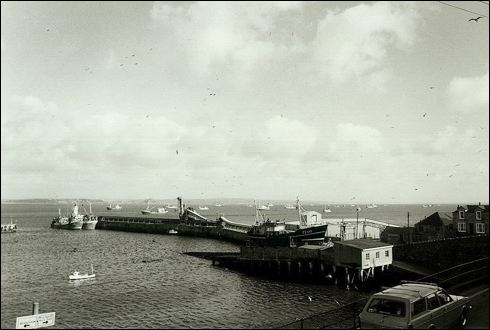Long life to the Pope!
Death to all our friends!
May the streets run in blood!
In the late-19th and early-20th centuries pilchards were so abundant in Cornish waters that such sentiments became popular toasts in the pubs of ports throughout the peninsula.
It is said that the blush of silver heralding the arrival of huge shoals in Mount’s Bay could be clearly seen from clifftops. And the annual harvest of oil-rich fish sustained entire communities as thousands of barrels of salted pilchards were shipped to Catholic countries of the Continent.
Places like Newlyn and Mevagissey were so crammed with vessels taking advantage of the good fishing that history records people walking from one side of the harbour to the other without getting their feet wet.
Even when larger East Coast boats from Lowestoft and Yarmouth joined in the annual hunt, stocks remained steady. Crews and jousters, merchants and shippers were all confident that, like night followed day, so the fish would keep on coming and the markets stay healthy.
One year, however, in the early years of the 20th century, there was a marked drop in the number of pilchards landed to Cornish ports. The following year saw fewer still, so that within a decade a fishery that had fed Cornish families for a generation was effectively a and end. Without the science to monitor fish stocks, it was impossible to work out why the silver harvest had ceased. Some blamed the weather, others the shift from sail to engines. Whatever the cause, the reality was all too clear to the fishing communities who found themselves suddenly without an income. So severe was the effect that poverty, starvation and emigration swept the ports of Cornwall.
A similar scenario followed a couple of generations later when, during the 1970s, Cornwall enjoyed what many describe as the “mackerel bonanza”. Unprecedented catches saw young “share” fishermen earning wages previously only dreamed of. Like their forebears, they thought it would go on forever.
 |
| Mount's Bay and the mackerel handline fleet in action - 1979 - with the freezer trawler Norse in the background. |
 |
| Almost the entire Scottish pelagic fleet at anchor in Mount's Bay - New year 1980 |
Much has been learned from their experiences – but perhaps not enough. Today, Cornwall again has a healthy pilchard industry. People nowadays prefer to call them sardines, but they’re the same fish as those caught in their millions during the 1890s.
 |
| Two Cornish Sardine boats in Newlyn |
Ten boats catch some 4000 tonnes of branded “Cornish Sardines” every year, contributing around £2 million to the local economy. The non-quota fishery, as it stands, is green and sustainable, has no by-catch, and does not damage the seabed. A highly-skilled operation, it requires an experienced crew of “hunters” to work the complex set of machinery involved in seine netting. It is also profitable. And for that reason crews fear a repeat of what happened to their predecessors. It is almost unheard of for a fisherman to ask for a restriction to be placed on what he catches – but that is exactly what is happening.
 |
| Stefan Glinski's sardine boat the White Heather |
Newlyn sardine fisherman Stefan Glinski has been catching fish in Cornish waters all his working life. The St Ives-born skipper says he has lost count of the times he has made requests to the Marine Management Organisation, as chairman of the Cornish Sardine Association, for a limit to be placed on the fishery to ensure stocks remain healthy.
“As an association, we keep asking, year after year, to have controls put in place to keep the fishery good, abundant and sustainable,” said Stefan. “I lived through what happened to the mackerel fishery and I wouldn’t want to see the same thing happen to sardines.
“We’ve asked the MMO to restrict it to 10 or 20 boats, but every time it falls on deaf ears. It seems nothing will be done until a fishery is in trouble. But we will continue to plead with them: please do something while the fishery is healthy.”
 |
| Landing sardines at night |
Looking at pictures of Stefan and his crew netting sardines, it is easy to draw a parallel with the sepia-tinted images of fishermen seining for pilchards a century ago. What’s more, it is impossible not to feel a sense of impending déja vu.
So come on, MMO, listen to those in the know and implement proper measures to ensure the survival of this important Cornish industry and way of life.Read more:
From the Western Morning News:
Most people think of it as a barbecue treat or a tinned staple, but the humble sardine is now worth around £2 million to Cornwall’s economy.
Over-fished almost to extinction at the beginning of the 20th century and largely ignored as a serious proposition by fishermen for decades, the small and oily member of the herring family has enjoyed a surge in popularity in recent years as consumers seek out cheap and healthy alternatives to haddock.
Now officially branded as Cornish Sardines, some 4000 tonnes are landed by 10 Cornish boats each year. Netting 1500 tonnes of them is Newlyn-based boat, White Heather. Skipper Stefan Glinski has been making a living from the sea all of his life – and at 56, he’s never been more successful.
“It’s an extremely green fishery,” said Stefan. “There’s no by-catch, we’re not damaging the seabed and we’re not catching stuff and throwing it away dead. Sardines is a very, very tick-the-box fishery.”
Born in St Ives, Stefan began his working life with stints tangle-netting for crayfish, mackerel trawling, crabbing and potting. After a few years he scraped together enough money – through a combination of grants, loans and borrowing from family members – to buy his own boat.
“The White Fish Authority offered me a 25 per cent grant and a 50 per cent loan at a cheap rate,” he said. “I had to find the other 25 per cent. I had no money and the banks wouldn’t look at me, so I went to my brothers, my mum, my gran, my uncles and all the rest, and begged a few pounds here, a few pounds there. I bought the boat and paid them all back in 18 months.”
After a few years of successful fishing, Stefan began to notice a rise in the number of sardines moving into inshore waters.
“No one was catching them and I started to think this was an untapped resource,” he said. “There wasn’t a market for sardines at the time because whenever anybody caught a few they found there was no price available and no process for selling them. Shippams had gone, so there was only Nick Howell at the Pilchard Works who salted a few for the Italian market.
“I could see there was a mass of these fish but I knew there was no point catching them and putting them on the market if no one was going to buy them. “But we were seeing them in huge numbers and I did begin to think it was a lot of money to be steaming over the top of every trip.”
Ever-resourceful and with an eye to an opportunity, Stefan invested in a small filleting and freezing facility in Hayle and began the almost single-handed revival of the great Cornish pilchard industry. The change in consumers’ attitudes couldn’t have been simpler: change the name.
“Historically, they were known as pilchards,” said Stefan. “But 15 years ago ‘pilchards’ didn’t appeal to consumers. Sardines, on the other hand, were being enjoyed by British holidaymakers in Portuguese and Spanish restaurants and on barbecues. “They’re the same fish, so we set about getting the name ‘Cornish Sardines’ registered.”
To begin with the demand from outlets like Nick Howell’s Pilchard Works in Newlyn was no more than two tonnes a week – hardly the basis for a good living.
“I decided take a gamble, build a boat and a net, and see how we got on,” said Stefan. “It’s not like other fisheries, though. The boats are quite complex and need bow and stern thrust and an awful lot of hydraulics. It’s expensive kit and the equipment all has to be spot-on. You can’t have a bolt or screw loose or missing in this kind of fishing because we’re stalking the fish, following them, shooting round them. In other fisheries you can lash things up and still get something – but this is very precise.”
Stefan’s other great innovation was to take the process by which fish are sold and turn it on its head. Fishermen the world over go to sea and bring their catch to market in the hope of getting a good price. By contrast, Stefan approached wholesale fish suppliers and asked them what they wanted.
“Instead of saying we have five tonnes this morning, how much will you give us for them, I would ring up the supplier the day before and say: this is the price, how much do you want tomorrow? That way the fish wholesaler or restaurateur was able to set a set price for the whole year. At first they didn’t believe I could fix the price for a whole year, but as it went on everybody saw the system worked and were happy with it.”
Fishing at night, from June to March, Stefan and three crewmen aboard White Heather – a converted North Sea prawn trawler – net 1500 tonnes of sardines.
Much of it – filleted, whole and smoked – is bought by shoppers in Marks & Spencer stores. Hannah Macintyre, the company’s fisheries specialist, said: “We have a proud heritage of working with great UK suppliers and our team works closely with Stefan to ensure the Cornish sardines are fished both sustainably and responsibly. Our customers clearly love them and we expect to sell more than 36 tonnes this summer.”
With the Cornish sardine industry estimated to be worth £2 million to the economy of Cornwall, Stefan believes the future may lie in smaller, species-specific fisheries.
“There is now a core of fishermen working within the parameters they’ve been set, rather than fighting it,” he said. “They’re getting stuck in and resigned to the fact that this is the way we have to make our living these days. People are specialising more and more. We specialise in sardines. We don’t do any other fishery, we don’t chop and change. In the end it’s the quality of the fish we sell that’s paramount. If we can do that, there’s a good future for the Cornish fishing industry.”
Read more:
Sites of interest:
Cornish Sardine web site
School of Cornish Sardines
Pilchard Works - sardine history
MSC accredited fishery
Protected Designation of Origin
